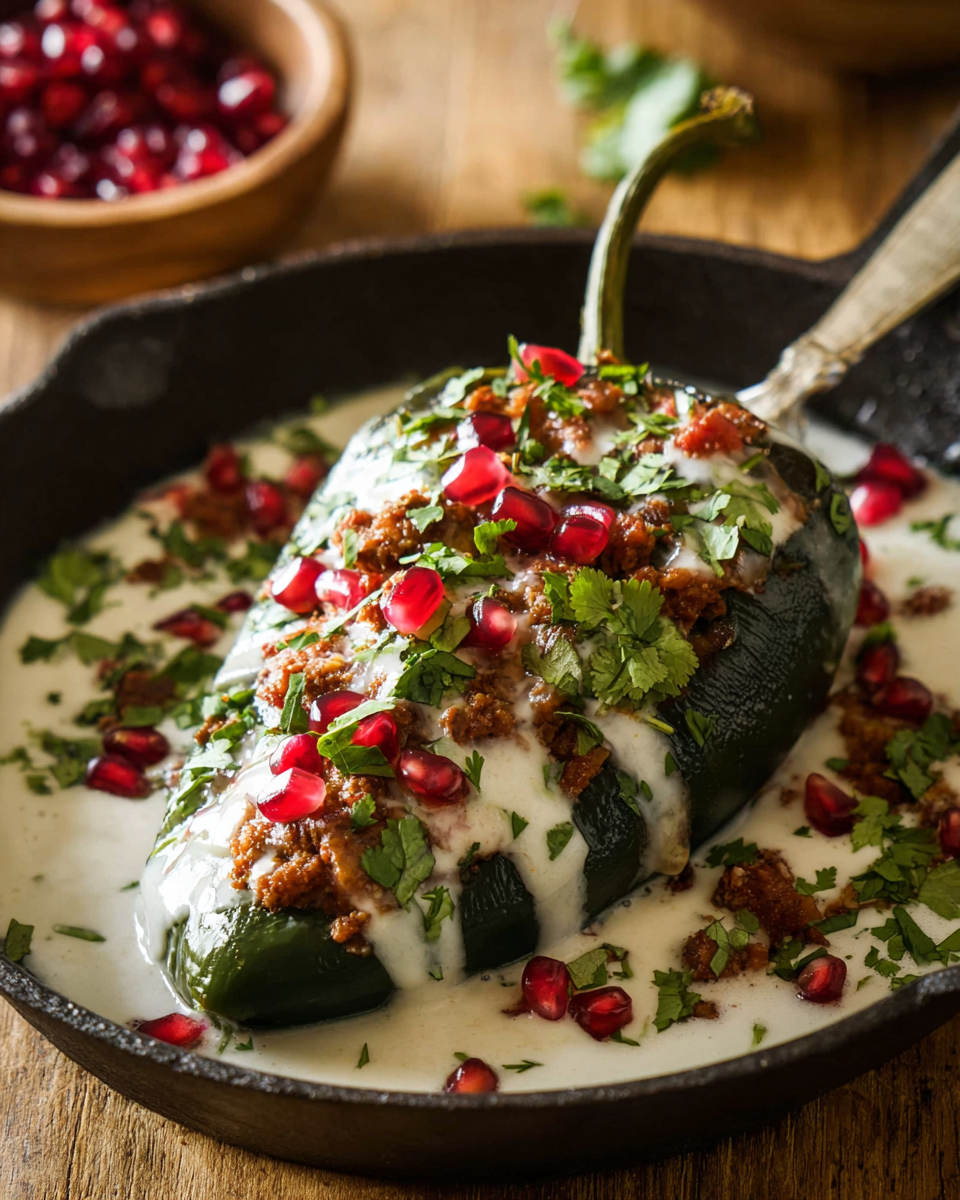Chiles en Nogada is a quintessential Mexican dish, combining the earthy richness of poblano chiles with the sweet-savory flavors of picadillo. The creamy walnut sauce adds a luxurious touch, making this dish not only a feast for the taste buds but also a feast for the eyes, especially when topped with vibrant pomegranate seeds.
The combination of flavors and textures in this dish tells a beautiful story of Mexican tradition and festive celebrations. The sweet dried fruits and the warmth of the spices in the picadillo complement the earthy, slightly spicy flavor of the poblano, while the walnut sauce smooths everything out. Whether for a family gathering or a special celebration, this dish will surely impress with both its complexity and elegance.
Full recipe:
Ingredients:
-
6 poblano chiles
-
1 lb ground pork
-
1/2 cup chopped onion
-
2 cloves garlic, minced
-
1/2 cup chopped tomatoes
-
1/2 cup dried apricots, chopped
-
1/4 cup raisins
-
1/4 cup almonds, chopped
-
1/4 cup candied citron, chopped
-
1 teaspoon cinnamon
-
1/2 teaspoon cloves
-
Salt and pepper to taste
-
1/2 cup walnuts
-
1/2 cup heavy cream
-
1 tablespoon sugar
-
1/4 cup pomegranate seeds
-
Fresh cilantro for garnish
Directions:
-
Preheat your oven to 400°F (200°C). Place the poblano chiles on a baking sheet and roast in the oven for about 15 minutes or until the skins are blistered. Remove and place them in a plastic bag to steam for 10 minutes. Peel off the skins and remove the seeds carefully.
-
In a large skillet, cook the ground pork over medium heat until browned. Remove excess fat and add the onion and garlic. Sauté until softened.
-
Stir in the tomatoes, apricots, raisins, almonds, and candied citron. Season with cinnamon, cloves, salt, and pepper. Cook for 5-7 minutes, stirring occasionally, until everything is well combined. Set aside to cool.
-
Stuff the roasted poblano chiles with the picadillo mixture, being careful not to tear the chiles.
-
For the sauce, place the walnuts, heavy cream, and sugar in a blender or food processor. Blend until smooth, adding more cream if necessary to achieve a sauce-like consistency.
-
Pour the walnut sauce over the stuffed chiles. Garnish with pomegranate seeds and fresh cilantro before serving.
Prep Time: 25 minutes | Cooking Time: 40 minutes | Total Time: 1 hour 5 minutes Kcal: 450 kcal | Servings: 6 servings
The Origins of Chiles en Nogada
The origins of Chiles en Nogada are linked to Mexico’s history. It is believed that the dish was created by nuns in Puebla in the 1820s to honor the Mexican independence hero Agustín de Iturbide. The story goes that they designed the dish with ingredients that symbolized Mexico’s patriotic colors—green, white, and red—during a time of national pride. Over time, Chiles en Nogada became a dish for celebrations, embodying the Mexican spirit.
Historically, the filling of picadillo would often include acitrón, a candy made from a cactus, but since this ingredient is difficult to find, dried fruits like pineapple are often used as substitutes. Regardless of the variations, Chiles en Nogada remains a beloved dish, often made during the late summer and early fall months when the ingredients are at their peak.
The Preparation Process
While the process of making Chiles en Nogada may seem intricate, it is well worth the effort for the flavors and visual appeal of the final dish. The first key step is roasting the poblano peppers, which can be done by either placing them under a broiler or over an open flame on a gas stove. This process allows the skin to blister and can be a bit tedious, but it is essential for the traditional texture and flavor of the dish. After roasting, the skins are peeled, and the seeds are carefully removed to make way for the picadillo filling.
The picadillo itself is a mixture of ground pork and beef, cooked with onions, garlic, and tomato sauce, which is then flavored with a blend of spices like cinnamon and cloves. Dried fruits such as raisins, pineapple, and other fresh fruits like apples and pears are added to create a perfect balance between savory and sweet. Afterward, the roasted peppers are stuffed with this filling.
The walnut sauce, or nogada, is made by blending skinned walnuts with cream, milk, and cheese to create a rich and smooth sauce that adds depth and creaminess to the dish. This sauce is then poured over the stuffed peppers, and the final garnish includes pomegranate seeds and fresh parsley, providing a burst of color and a touch of freshness.
The Cultural Significance of Chiles en Nogada
Chiles en Nogada is more than just a meal—it’s a celebration of Mexican culture. The dish reflects the rich history of Mexico, where food is intricately linked to traditions and national pride. It is often served during significant events like Mexican Independence Day, but it is also enjoyed year-round for family gatherings, festivals, and other special occasions.
The flavors of Chiles en Nogada evoke a sense of nostalgia and pride for many Mexicans, as it represents not only the beauty of their national colors but also the fusion of indigenous and Spanish culinary influences. The combination of roasted peppers, seasoned meat, sweet fruits, and creamy sauces symbolizes the diversity and richness of Mexican cuisine.
A Step Toward Preserving Culinary Heritage
Making Chiles en Nogada at home can feel like a labor of love, but it is also a way of preserving a piece of Mexican culinary history. With every preparation, from peeling the walnuts to carefully stuffing each pepper, you are not only crafting a delicious meal but also participating in a tradition that has been passed down for generations. By taking the time to make this dish, you are contributing to the preservation of a cultural legacy.
Moreover, while Chiles en Nogada is steeped in tradition, it is also a dish that invites creativity and customization. Many modern variations allow the use of different fruits, cheeses, or even frying the stuffed peppers in an egg batter for added texture. These adaptations show the flexibility of Mexican cuisine and how it continues to evolve while maintaining its roots.
The Ingredients: A Harmony of Sweet and Savory
One of the most striking features of Chiles en Nogada is the harmony of sweet and savory elements that come together in the filling. The balance of the rich, slightly spicy poblano pepper with the picadillo filling, which is a mixture of ground meats and fruit, creates a perfect contrast. The inclusion of fruits like raisins, plantains, and apples provides natural sweetness, while the cinnamon and cloves add warmth and depth.
The walnut sauce (nogada) provides a creamy, slightly tangy base that brings everything together. The mixture of milk, crema, goat cheese, and queso fresco creates a luscious sauce that complements the richness of the filling. The touch of sugar and cinnamon enhances the sweetness of the sauce, balancing the savory nature of the filling.
Finally, the pomegranate seeds add a pop of color and a tartness that cuts through the richness of the dish, while the fresh parsley gives it a fresh and herby finish.
Serving and Storing Chiles en Nogada
Once assembled, Chiles en Nogada should be served immediately to enjoy the freshness of the pomegranate and the creaminess of the walnut sauce. It is traditionally accompanied by rice or beans, but it can also stand alone as a centerpiece of any festive meal.
If you have leftovers, you can store the stuffed peppers and the walnut sauce separately in airtight containers in the refrigerator. They will keep for up to five days, though the peppers may soften slightly over time. To reheat, place the stuffed peppers in the oven at 375°F for 5-10 minutes, and then pour the walnut sauce over the top before garnishing with pomegranate seeds.
Conclusion
Chiles en Nogada is a dish that tells the story of Mexican culture and its culinary history. With its vibrant colors, harmonious flavors, and cultural significance, it is no surprise that this dish is often called the national dish of Mexico. Whether prepared for a special occasion or as a way to bring a taste of tradition to the table, Chiles en Nogada continues to be a beloved recipe that has stood the test of time. While the process of making this dish may seem intricate, the result is a stunningly flavorful meal that encapsulates the heart and soul of Mexico’s rich food heritage.






